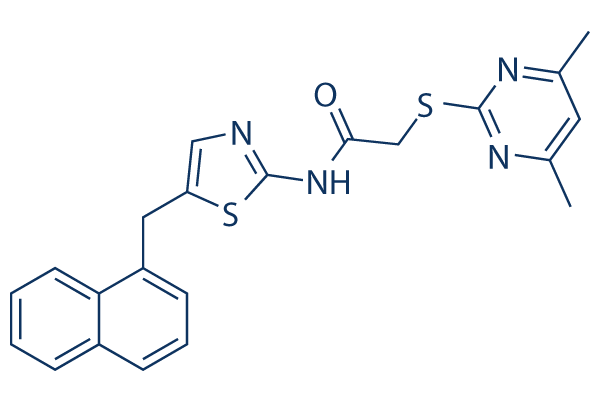|
受注:045-509-1970 |
技術サポート:tech@selleck.co.jp 平日9:00〜18:00 1営業日以内にご連絡を差し上げます |
化学情報

|
Synonyms | N/A | Storage (From the date of receipt) |
3 years -20°C powder 1 years -80°C in solvent |
|||||||||||
| 化学式 | C22H20N4OS2 |
||||||||||||||
| 分子量 | 420.55 | CAS No. | 709002-46-0 | ||||||||||||
| Solubility (25°C)* | 体外 | DMSO (warmed with 50ºC water bath) | 84 mg/mL (199.73 mM) | ||||||||||||
| Water | Insoluble | ||||||||||||||
| Ethanol | Insoluble | ||||||||||||||
| 体内 (毎回新しく調製した物を用意してください) |
|
||||||||||||||
|
* <1 mg/ml means slightly soluble or insoluble. * Please note that Selleck tests the solubility of all compounds in-house, and the actual solubility may differ slightly from published values. This is normal and is due to slight batch-to-batch variations. |
|||||||||||||||
溶剤液(一定の濃度)を調合する
生物活性
| 製品説明 | SirReal2 is a potent and selective Sirt2 inhibitor with IC50 of 140 nM. |
|---|---|
| in vitro | SirReal2 selectively inhibits Sirt2 via a Sirt2-specific amino acid network, and induces a tubulin hyperacetylation and a significant depletion of BubR1 in HeLa cells. [1] |
| in vivo | In vivo, SirReal2 inhibits Sirt2 activity without affecting the activity of the other Class-I sirtuins Sirt1 and Sirt3. [1] |
プロトコル(参考用のみ)
| キナーゼアッセイ | In vitro sirtuin assay | |
|---|---|---|
| Initial screens are conducted with a high-throughput fluorescence-based assay using the substrate ZMAL (Z-Lys(Acetyl)-AMC) that is synthesized. For this human Sirt1133–747, human Sirt225–389, human Sirt3101–399 or Sirt3118–395 are mixed with assay buffer (50 mM Tris/HCl, 137 mM NaCl, 2.7 mM KCl, 1 mM MgCl2, pH 8.0), β-NAD+ (final assay concentration 500 μM), the substrate ZMAL (final assay concentration 10.5 μM from a 12.6 mM stock solution in DMSO) and the respective inhibitor in DMSO at various concentrations or DMSO as a control (final DMSO concentration 5–20% (v/v)). The mixture is incubated at 37 °C for 4 h, with agitation at 150 r.p.m. Deacetylation is then stopped by the addition of a solution containing NCA and trypsin (50 mM Tris/HCl, 100 mM NaCl, 6.7% (v/v) DMSO, trypsin 5.5 U/μL, 8 mM NCA, pH 8.0, 60 μL) and the mixture is then incubated for tryptic digestion of the deacetylated product to release the fluorophor (20 min, 37 °C, 150 r.p.m.). Then the fluorescence intensity is measured in a microplate reader (λex 390 nm, λem 460 nm). The amount of inhibition is determined with respect to the mixture with only DMSO. IC50 values are determined with Graphpad Prism software using a non-linear regression to fit the dose–response curve. SirReal1 and this compound are also tested for Sirt1–3 inhibition with a non-labelled acetyl-lysine peptide substrate (based on α-tubulin with two additional tryptophans (residues 36–44, H-PSDK(Acetyl)TIGGWW-NH2, 10 μM). This chemical is also tested for Sirt5–6 inhibition with non-labelled acyl-lysine peptide substrates (Sirt5: Benzoyl-GVLK(Succinyl)EYGV-NH2, 10 μM; Sirt6: Ac-EALPKK(Myristoyl)TGG-NH2, 10 μM) The substrate is incubated (10 min, ~0.5 μM Sirt1/2/3/5/6, 500 μM β-NAD+, 5–20% (v/v) DMSO, 50 mM Tris/HCl, 137 mM NaCl, 2.7 mM KCl, 1 mM MgCl2, pH 8.0), stopped by the addition of trifluoroacetic acid (TFA, 10% (v/v), final concentration 1% (v/v)). The components of the stopped reaction mixture are separated by HPLC (Agilent 1100, Phenomenex reversed phase column Kinetex RP18 2.7 μm, 50 × 3 mm) using a linear gradient of acetonitrile (20–60% (v/v) acetonitrile, 0.1% (v/v) TFA, 0.6 ml/min). Peaks of acetylated and deacetylated substrate are quantified by absorption at 280 nm. Sirt4-dependent deacetylation reactions are performed with an acetylated Nnt397-peptide (H-NITKLLK(Acetyl)AISPDK-NH2, 250 μM, GL Biochem., in 50 mM Tris/HCl, 150 mM NaCl, pH 7.5). Samples are taken between 0 and 45 min and reactions were stopped by mixing 1:1 with 0.5% (v/v) TFA. The samples are then diluted to a peptide concentration of 5 μM with 0.1% (v/v) formic acid and analysed on an EASY-nLCII connected to a LTQ mass spectrometer. Peptides are separated by a linear gradient of acetonitrile (0–100% (v/v), 0.1% (v/v) TFA, 300 nL/min) on a reprosil C18 reversed phase column. Peak areas of acetylated and deacetylated peptides are extracted using Skyline55. A solution with DMSO is used as a negative control while a solution with the physiological inhibitor NCA served as a positive control. | ||
参考
|
Selleckの高級品が、幾つかの出版された研究調査結果(以下を含む)で使われた:
| Effects of Dimerization on the Deacylase Activities of Human SIRT2 [ Biochemistry, 2023, 10.1021/acs.biochem.3c00381] | PubMed: 37966275 |
| Effects of Hst3p inhibition in <i>Candida albicans</i>: a genome-wide H3K56 acetylation analysis [ Front Cell Infect Microbiol, 2022, 12:1031814] | PubMed: 36389164 |
| The Anticancer Effect of a Flavonoid-Rich Extract of Bergamot Juice in THP-1 Cells Engages the SIRT2/AKT/p53 Pathway [ Pharmaceutics, 2022, 14-102168] | PubMed: 36297603 |
| The SIRT2 Pathway Is Involved in the Antiproliferative Effect of Flavanones in Human Leukemia Monocytic THP-1 Cells [ Biomedicines, 2022, 10-102383] | PubMed: 36289647 |
| LncRNA LncHrt preserves cardiac metabolic homeostasis and heart function by modulating the LKB1-AMPK signaling pathway [ Basic Res Cardiol, 2021, 116(1):48] | PubMed: 34379189 |
| LncRNA LncHrt preserves cardiac metabolic homeostasis and heart function by modulating the LKB1-AMPK signaling pathway [ Basic Res Cardiol, 2021, 116(1):48] | PubMed: 34379189 |
| SIRT2 promotes murine melanoma progression through natural killer cell inhibition [ Sci Rep, 2021, 11(1):12988] | PubMed: 34155309 |
| SIRT1 inhibitors mitigate radiation-induced GI syndrome by enhancing intestinal-stem-cell survival [ Cancer Lett, 2020, 501:20-30] | PubMed: 33359449 |
| A novel role of SIRT2 in regulating gap junction communications via connexin-43 in bovine cumulus-oocyte complexes. [ J Cell Physiol, 2020, 10.1002] | PubMed: 32039484 |
| SIRT2 Inhibition Results in Meiotic Arrest, Mitochondrial Dysfunction, and Disturbance of Redox Homeostasis during Bovine Oocyte Maturation. [ Int J Mol Sci, 2019, 20(6)] | PubMed: 30889926 |
長期の保管のために-20°Cの下で製品を保ってください。
人間や獣医の診断であるか治療的な使用のためにでない。
各々の製品のための特定の保管と取扱い情報は、製品データシートの上で示されます。大部分のSelleck製品は、推薦された状況の下で安定です。製品は、推薦された保管温度と異なる温度で、時々出荷されます。長期の保管のために必要とされてそれと異なる温度で、多くの製品は、短期もので安定です。品質を維持するが、夜通しの積荷のために最も経済的な貯蔵状況を用いてあなたの送料を保存する状況の下に、製品が出荷されることを、我々は確実とします。製品の受領と同時に、製品データシートの上で貯蔵推薦に従ってください。
